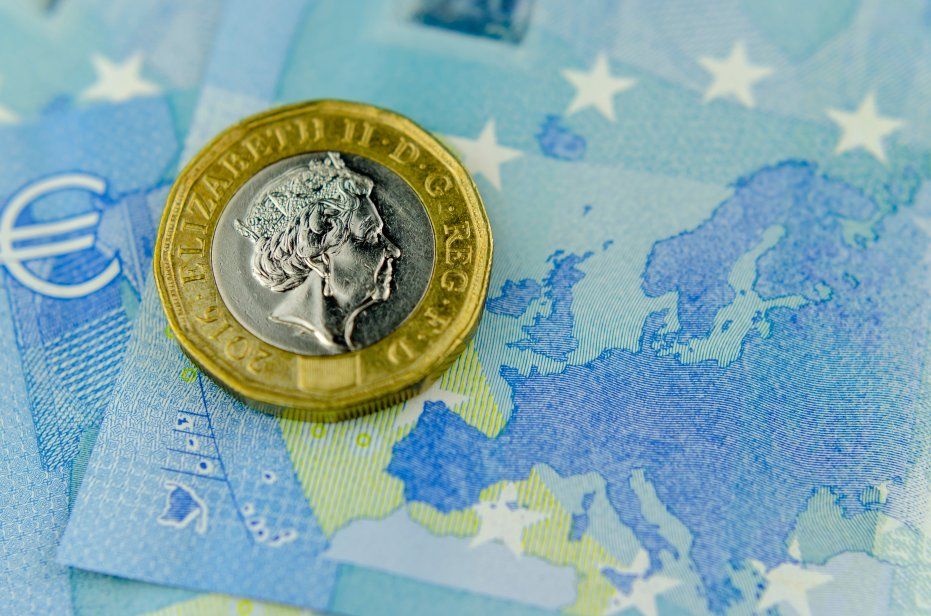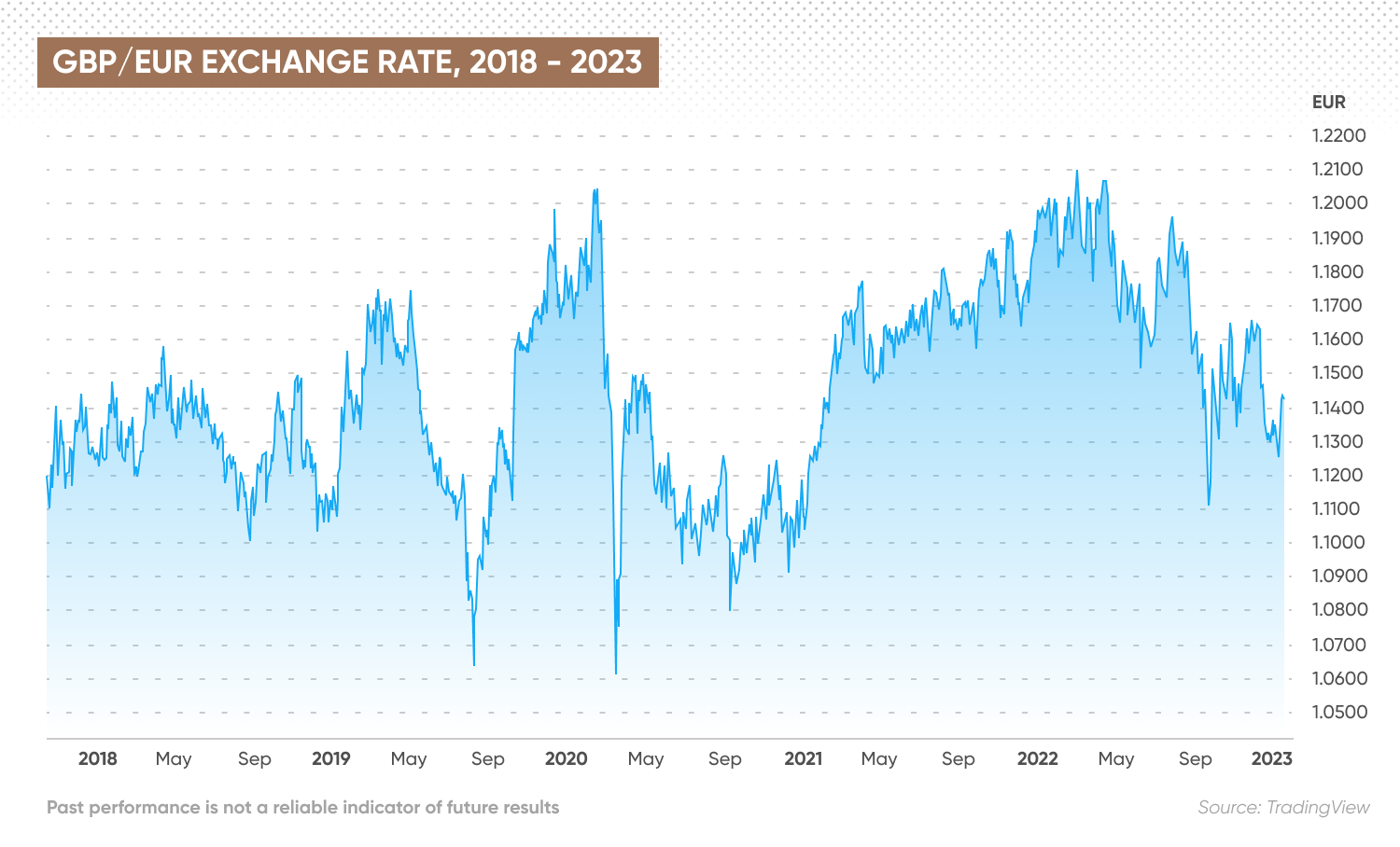GBP/EUR forecast: Will the pound rise against the euro in 2023?
The British pound has been moving sideways against the euro, yet can it regain momentum? Read on for a GBP/EUR forecast.
The British pound (GBP) has regained some of its 2022 momentum against the euro (EUR). After briefly reaching a low of 1.11 in February, the exchange rate rose to 1.155 on 10 May, its highest level since December 2022.
The start of 2023 was a whirlwind of of mixed economic data, banking industry turmoil and monetary policy tightening. March came and the Bank of England (BoE) raised interest rates by 25 basis points (bps) at its March meeting, bringing the rate to 4.25%. Meanwhile, on the continent the European Central Bank (ECB) hiked rates by 50 bps to 4%, the highest level since the 2008 financial crisis.
With both UK and eurozone economies under pressure from inflation and rate hikes, what does the outlook look like for the GBP/EUR foreign exchange (forex) rate?
Patrick Locke, Global FX Strategist at J.P. Morgan said:
“Markets are still pricing the pound as an underperformer and we think that should continue.”
In this article, we look at the latest GBP/EUR predictions from analysts, and what factors will influence the exchange rate in the future.
EUR/GBP live exchange rate
What drives the GBP/EUR pair?
The GBP/EUR pair represents how many euros – the quote currency – are needed to buy one British pound – the base currency.
The pair is one of the most frequently traded on the FX markets. Sterling is the former global reserve currency and one of the strongest in the world, while the euro is the second most traded currency in the world after the US dollar (USD). Both the GBP and EUR represent major global financial and trading centres.
Macroeconomic indicators, including GDP, inflation, interest rates, services and manufacturing activity and unemployment, market sentiment and consumer confidence, all drive the currency markets, as they affect a country’s attractiveness to investors and, in turn, demand for its currency. These economic readings are key in shaping a GBP/EUR forecast.
Market sentiment is a key driver for the GBP/EUR pair. The uncertainty surrounding negotiations between the UK and the EU over the UK’s exit from the bloc have weighed on the value of sterling since the 2016 referendum.
More recently, concerns over the impact of the Russia-Ukraine war on inflation in the UK and the eurozone have influenced the direction of the exchange rate.
GBP/EUR trend reflects economic volatility
After falling in March 2020 from 1.20 to 1.08 on concerns about the impact of the Covid-19 pandemic on the UK economy, the GBP/EUR pair has remained volatile. The rate quickly moved up to 1.1495 in April 2020, but then trended lower over the summer to return to the 1.08 level in September 2020.
The pair then began to trend higher as the introduction of Covid-19 vaccines raised hopes that the UK economy would start to recover from lockdowns.
The upward trend continued into 2021, with the pair reaching 1.1761 in late March. The pair dipped to 1.1474 in April 2021 but then moved into a trading range between 1.16 and 1.18 for the rest of the year.
The GBP/EUR pair moved above 1.19 in January 2022, after the Bank of England (BoE) kicked off a series of interest rate hikes in December 2021 with a 15-basis point increase to 0.25%.
The GBP/EUR pair briefly moved back above 1.21 in late February 2022 as traders weighed the impact of the Russian invasion of Ukraine on the eurozone economy, anticipating a stronger impact than on the UK economy. But the pair began to slide in April and dropped to 1.16 on 26 June 2022.
The pair struggled through high volatility throughout August and September 2022, dropping to an intraday low of €1.08 on 26 September following a disastrous mini-budget of the Liz Truss government.
Since then the British pound recovered some losses, yet moved lower in 2023. Since the start of the year, the pair has been trading between 1.11 and 1.14 for the first three months of 2023.
INFOGRAPHICS: PLEASE REDESIGN THE CHART BELOW, without today’s price
GBP/EUR exchange rate, 2018 - 2023
UK economy proved more resilient
The pound has shown resilience in the last month amid better than expected UK economic performance. The kingdom’s employment rate stood strong at 75.7% between November 2022 and January 2023, 0.1% higher than the previous ONS reading. Meanwhile, the economy expanded by 0.3% month-on-month in January, beating the 0.1% growth expected by analysis. Jane Foley, Rabobank’s senior FX strategist, commented on 22 March:
“Over the past month the GBP has proved to be resilient. It remains the second best performing G10 currency on a 1-month view after the safe-haven JPY. This reflects a re-evaluation of the UK economic backdrop. Whilst the line up of UK fundamentals is not great, it is better than the market had been expecting.”
Meanwhile, the UK’s inflation is still a concern for the British currency. The consumer price index (CPI) rose by 10.4% in the 12 months to February 2023, up from 10.1% in December.
HSBC, however, has revised down their inflation forecast when the UK government announced the energy price freeze at the current levels. Elizabeth Martins, HSBC’s senior economist, commented:
“There are some additional disinflationary risks including a further fall in oil prices in recent days and an update from Cornwall Insight, suggesting that the Ofgem price cap could fall to £2,013 in July - a 19.5% fall from the current average annual household bill of £2,500. (Though the real impact may not be so big, with the end of the government's £66/month subsidy, that is not accounted for in inflation). But this needs to be set against the rise in food and core prices in today's print. The great debate between inflation and disinflation, and the risks of overtightening versus under tightening, remains unresolved.”
Banking turmoil
The banking fallout triggered by the collapse of the US-based Silicon Valley Bank that saw troubled Credit Suisse being taken over by rival UBS has hurt investors’ confidence in the Eurozone, hitting the European currency and the block’s banking stocks.
The current ECB rhetoric is that the banking sector is strong, aimed at restoring market sentiment. Yet as explained by Rabobank’s Jane Foley:
“If policymakers on both sides of the Atlantic can convince investors that the financial system is sound, then it follows that they will have more scope to focus on price pressures. ECB speakers have made it very clear that they remain concerned about underlying inflation pressures. This morning ECB President Lagarde warned that the Eurozone ‘could see a more prolonged cost-push shock coming from wage growth’.”
GBP/EUR forecast for 2023 and beyond
In their latest outlook issued on 20 March, Citibank was bullish on the British pound, predicting the GBP rise to $1.22 in the next three months, accelerating to $1.25 in 6-12 months, and trading at $1.40 in the long-term. The US investment bank’s forecast for EUR/USD saw the currency pair trading at $1.10 in three months, $1.15 in 6-12 months, and $1.20 in the long-term.
While Citibank didn’t provide a direct pound to euro we can calculate their GBP/EUR forecast for 2023 from the price targets above.
The cross rate from the forecasts above concludes that the bank expected the rate to trade at €1.109 in three months, slumping to €1.08 in the next year, yet recovering to €1.166 in the long term.
Meanwhile, Rabobank’s Jane Foley expected EUR/GBP to edge to £0.88 in the next three months, which would amount to the GBP/EUR forecast of €1.136. The market strategist said that further policy by BoE would be key in determining the outlook:
“Ahead of the recent financial sector tensions, the question of whether the BoE could be approaching a pause in policy had already been raised in the market. BoE Chief Economist Pill had raised the topic of overtightening given the extent of the policy moves already announced this cycle. The BoE can be expected to offer further reassurances around the banking sector this week. Given the current uncertainties, there may be little by way of forward guidance on policy. We have pared back our EUR/GBP forecasts and expected the pair at 0.88 on a 3 month view.”
Analysts at JP Morgan have forceasted that the GBP/USD is forecast to fall to 1.18 in June 2023, to 1.16 in September 2023 and to 1.15 in December 2023.
Locke said:
“Although the U.K. has some exposure to the drivers of better European growth, namely lower gas prices, it is also perhaps less primed to benefit from this given lower trade intensity with the continent post-Brexit.”
As of 12 May, the GBP/EUR forecast from TradingEconomics expected the exchange rate to trade at 1.24 by the end of the second quarter of 2023, and at 1.11939 in early 2024, based on global macro models projections and analysts expectations.
The GBP/EUR forecast for 2023 from algorithm-based forecaster Wallet Investor was bullish on the long-term outlook, predicting that the pair could trade at 1.124 in early 2024, and at 1.158 in five years’ time. The site’s GBP/EUR forecast for 2025 saw the pair trading at 1.133 in January of that year.
Analysts have not issued a GBP/EUR forecast for 2030, yet Wallet Investor went as far as 2028, predicting the pair to start that year at 1.158.
Final thoughts
When evaluating any pound to euro forecast, it’s important to keep in mind that forex markets are highly volatile, making it difficult to make accurate long-term estimates. Hence analysts’ and algorithm-based predictions are often wrong. We recommend that you always do your own research. Look at the latest news, a wide range of commentary, technical and fundamental analysis before trading.
Keep in mind that past performance is no guarantee of future returns, and never trade more money than you can afford to lose.
FAQs
Why has GBP/EUR been moving sideways?
The GBP/EUR currency pair started 2023 on a strong foot amid reports of strong UK labour market and upbeat corporate earnings data, which may mean more aggressive interest rate hikes by the Bank of England (BoE). However, since then GBP/EUR exchange rate has been caught in a whirlwind of mixed economic data, banking industry turmoil.
Will GBP/EUR go up or down?
As of 20 March, Citibank expected GBP/EUR to trade at €1.109 in three months, slumping to €1.08 in the next year, yet recovering to €1.166 in the long term. Meanwhile, Rabobank’s prediction was €1.136 in the next three months. Note that their predictions can be wrong.
When is the best time to trade GBP/EUR
The busiest time for the GBP/EUR market is typically during European trading hours between 07:00-16:00 GMT. Releases of major macroeconomic data and monetary policy statements tend to drive volatility on currency markets, increasing liquidity and creating opportunities for traders to profit. However, you should keep in mind that high volatility increases risks of losses.
Is GBP/EUR a buy, sell or hold?
How you should trade the GBP/EUR pair is a personal decision you should make based on your risk tolerance, investing strategy and portfolio composition, after researching the market to understand the latest trends, news and analysis. Keep in mind that past performance is no guarantee of future returns, and never trade money you cannot afford to lose.